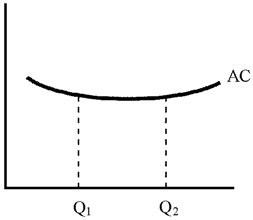Figure 11-8

Given the average cost curve shown in Figure 11-8 for dry cleaning, where Q1 is the quantity demanded in a small town, and Q2 for a larger town, you would expect dry cleaning to be a monopoly
a.
in a small town, but not a large one.
b.
in both large and small towns.
c.
in a large town, but not a small one.
d.
only if the process is patented.
a
You might also like to view...
Refer to Figure 13-17. Suppose the firm is currently producing Qf units. What happens if it increases its output to Qg units?
A) It will move from a zero profit situation to a loss situation B) Its average cost of production will fall and its profit will rise. C) It will move from a zero profit situation to a profit situation D) It will be taking advantage of economies of scale and will be able to lower the price of its product.
The Washington Consensus refers to
a. agreements between Republicans and Democrats b. guidelines for limiting government intervention, supported by the World Bank andInternational Monetary Fund c. the agreement as to where to locate the U.S. government d. guidelines for providing U.S. aid to developing-country governments e. guidelines for providing federal aid to state and local governments
Monopsonistic exploitation refers to
A) the payment to the resource equal to MFC. B) the payment to a resource less than MRP. C) the payment to a resource equal to MRP. D) the payment to a resource above MRP.
The rights of a co-owner to a share of a firm's profits are
a. protected under tort law b. protected under contract law c. not protected under any form of law d. protected under antitrust law e. less valuable than the costs of pursuing action against the company